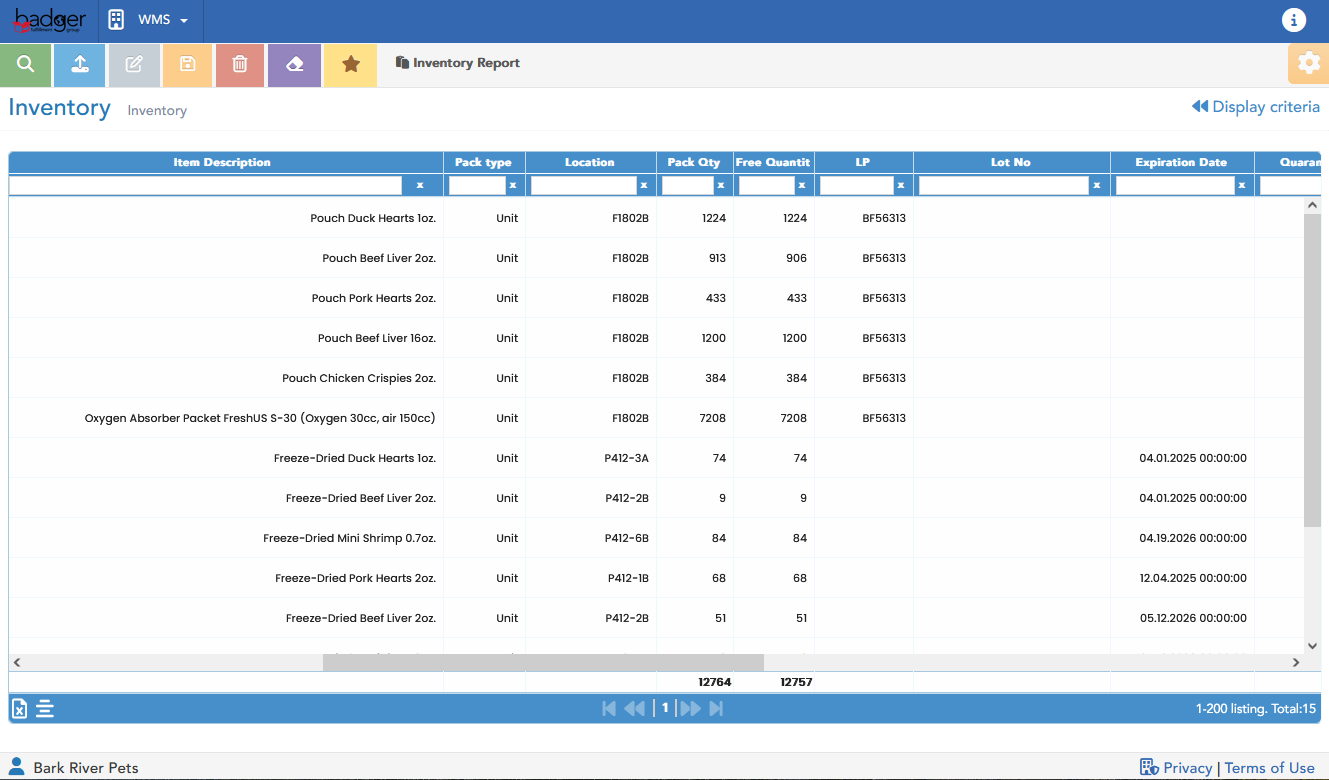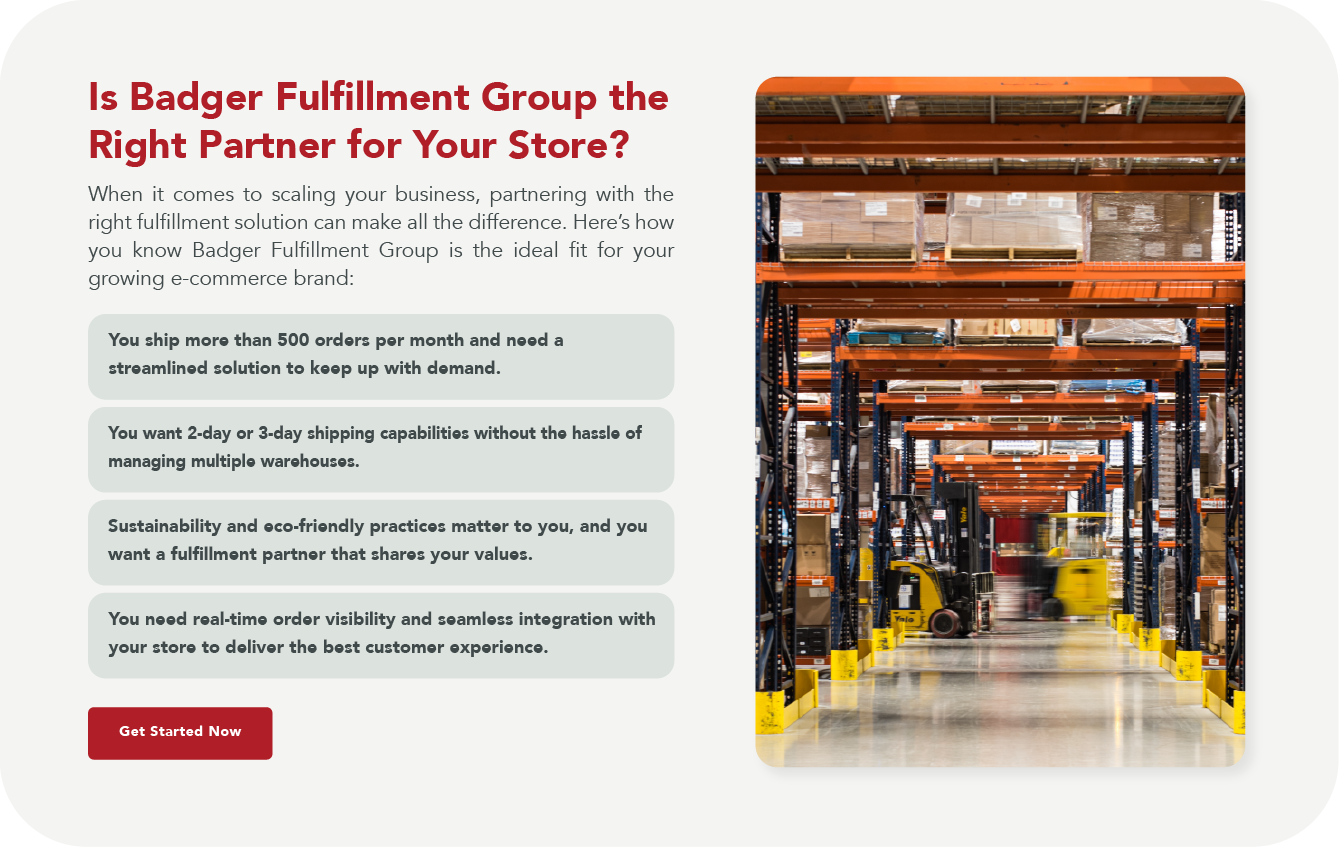The pick, pack, and ship process is an essential part of the supply chain for e-commerce businesses. This sequence of steps ensures that customer orders are accurately fulfilled and quickly shipped, playing a key role in customer satisfaction. As customers expect fast and reliable delivery, businesses that master an efficient pick, pack, and ship process gain a competitive edge, meeting demands while keeping shipping costs under control.
In this we will look at each phase of the pick, pack, and ship process and why it’s essential for effective order fulfillment. We will explore:
Key Sections:
- The Role of Order Management Systems in Pick, Pack, and Ship
- The Three Key Steps of E-Commerce Fulfillment
- Warehouse Management for an Efficient Pick, Pack, and Ship Process
- Warehouse Layout and Slotting
- Warehouse Management Systems (WMS)
- What Makes Badger Stand Out in the Pick, Pack, and Ship Process
The Role of Order Management Systems in Pick, Pack, and Ship
An Order Management System (OMS) is critical to coordinating the pick, pack, and ship process. An OMS tracks customer orders from purchase to delivery, synchronizing with Warehouse Management Systems and shipping software to keep operations smooth. By managing real-time inventory levels, automating order routing, and integrating with carriers, an OMS ensures that orders are accurately picked, packed, and shipped on time. This system plays an essential role in maintaining customer satisfaction, reducing fulfillment errors, and enhancing overall supply chain efficiency.
The Three Key Steps of E-Commerce Fulfillment
The pick, pack, and ship process is the process of order fulfillment once an order is received from the OMS.
1. Picking
Picking is the initial step in the order fulfillment process, where items are gathered from inventory to fulfill customer orders. This step requires precision and organization to minimize errors and ensure efficient picking. The average industry picking accuracy rate is around 99.5% when barcoding and scanning technologies are fully integrated into the order-picking process. This high level of accuracy helps reduce order errors, improve customer satisfaction, and minimize returns and additional handling costs associated with inaccuracies. Accurate picking is crucial, as it directly impacts operational costs and the customer experience, which is why it’s a key performance indicator in warehouse logistics. The picking and packing process has various methods, each catering to different types of businesses and warehouse setups.
- Piece Picking: Also known as single order picking, this method involves picking items for one order at a time. It’s straightforward but can be time-consuming for larger volumes.
- Batch Picking: In this method, picked items for multiple orders are grouped together in one trip through the warehouse. This technique improves efficiency by reducing the number of trips, particularly when orders share common items.
- Zone Picking: In zone picking, the warehouse is divided into specific zones, with each picker responsible for gathering items within their designated area. For orders containing items from different zones, the picked items are combined at the packing station.
- Wave Picking: Combining aspects of batch and zone picking, wave picking involves organizing orders to be picked from multiple zones simultaneously. This method is ideal for handling high order volumes while maintaining speed and accuracy.

Badger FG Employees Picking Product
- Packing
Once items are picked, they move to the packing station, where they are prepared for shipping. Packing ensures that customer orders are securely packaged to prevent damage in transit, ultimately enhancing customer satisfaction.
- Packing Materials: The packing process involves selecting appropriate materials, such as boxes, poly mailers, and padding, to protect items based on their size, weight, and fragility. Using the right packing materials minimizes shipping costs and optimizes package dimensions.
- Packing Slip and Shipping Label: Each order is matched with a packing slip, listing the items within, which is included in the package for customer verification. The shipping label, which includes all necessary information for the carrier, is affixed to the package, ensuring proper routing.
- Main Types of Packing:
- Box Packing: Typically used for items requiring additional protection.
- Bag Packing: Suitable for smaller, non-fragile items that don’t need significant padding.
- Poly Mailers: Lightweight and cost-effective, ideal for soft goods.
- Custom Packing: For delicate or irregular items that need specific protection.
3. Shipping
Shipping is the final step, where the packed order is sent out to the customer. The choice of shipping method impacts both delivery speed and shipping costs, which are essential factors in meeting customer expectations.
Main Types of Shipping:
- Standard Shipping: Common for most e-commerce businesses, offering economical delivery at a standard pace.
- Expedited Shipping: Provides faster delivery at a higher cost, catering to customers who value speed.
- Same-Day/Next-Day Shipping: High-demand service for urgent delivery needs, typically within a specific distance.
- Freight Shipping: Used for large or bulk orders that require special handling and transport.
According to recent data, 75% of consumers expect affordable, fast delivery when shopping online, which highlights the importance of choosing the right shipping options to align with customer expectations. Selecting the right carrier and delivery method can improve customer satisfaction and enhance the brand’s reputation for reliable service.

Badger FG Warehouse – Ready to Ship
Warehouse Management for an Efficient Pick, Pack, and Ship Process
Effective warehouse management is key to streamlining the pick, pack, and ship process. Proper warehouse layout, organization, and inventory management practices create an environment where orders are picked, packed, and shipped with maximum efficiency. See below for screenshot from Badger Fulfillment’s WMS Inventory Management Screen.

Badger FG Warehouse Management System (WMS)
Warehouse Layout and Slotting
The layout of a warehouse significantly influences the picking process. Slotting, the practice of organizing inventory based on item demand and frequency, is essential in ensuring that high-demand products are in easily accessible areas. This minimizes travel time for pickers and enhances overall efficiency.
Warehouse Management Systems (WMS)
A Warehouse Management System (WMS) supports real-time inventory tracking and order management, enabling accurate picking and reducing errors. A WMS helps coordinate all aspects of the pick, pack, and ship process, including order routing, stock control, and labor management, to ensure a seamless flow of operations.
What Makes Badger Stand Out in the Pick, Pack, and Ship Process?
Badger Fulfillment Group is committed to providing seamless and efficient order fulfillment. Here’s what sets Badger apart:
Sustainability at Badger Fulfillment Group
Badger Fulfillment Group is dedicated to sustainability, offering eco-friendly packaging options, optimizing storage and shipping to reduce waste, and partnering with carriers who prioritize environmental responsibility. By integrating these practices into our operations, we help businesses lower their carbon footprint while maintaining efficiency and meeting customer expectations.
24-Hour Receiving for Quick Processing
Affordable 2-Day Shipping
Badger’s access to economical 2 and 3 day shipping options means e-commerce businesses can offer quick delivery without sacrificing cost efficiency. This service helps businesses meet customer demands for speedy delivery and improves customer satisfaction.
Streamlined and Efficient Fulfillment
Badger’s fulfillment process is designed for speed and accuracy, with optimized storage, picking, packing, and shipping workflows that handle high volumes efficiently. This approach reduces errors, controls costs, and supports businesses in delivering a dependable customer experience.
The pick, pack, and ship process are the backbone of successful e-commerce fulfillment, enabling businesses to meet customer expectations for fast, accurate deliveries while keeping operations efficient. Badger Fulfillment Group as a sustainably focused 3PL brings this process to life with a commitment to 24-hour receiving, affordable 2-day shipping, and scalable solutions tailored to each business. With real-time visibility and technology-driven processes, Badger offers reliable order accuracy and speed, helping businesses optimize costs and easily adapt to growth. Choosing Badger means partnering with a team dedicated to enhancing your fulfillment experience and supporting your success in today’s competitive e-commerce market.



